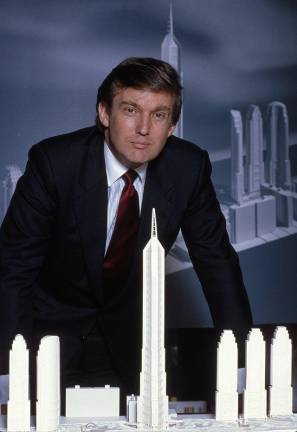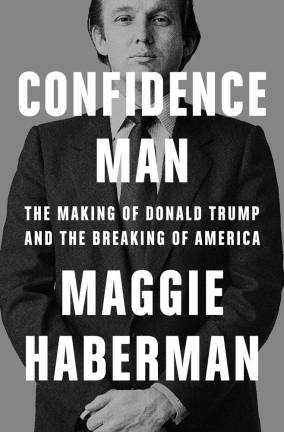One of the great ironies of the Trump era is how utterly many New Yorkers would love to disown him even though he is very much one of our own.
It is not just that Trump is from The Great City. Much of what he is can be traced back to the people and places Trump experienced in New York on the way to becoming who he became. Trump didn’t so much make it here, as he made himself out of what he learned here from fellow New Yorkers, everyone from Roy Cohn and Meade Esposito to George Steinbrenner, Ed Koch and Rudy Giuliani.
No one has captured this process of creation better than Maggie Haberman, herself a born and raised West Sider whose parents met at Trump’s favorite newspaper, The New York Post. She followed them into the news business and found herself frequently following the activities and antics of this middling New York developer and self-made celebrity.
“From Ed Koch and Rudy Giuliani, he learned about showmanship in office,” Haberman writes in her new book about Trump. “And from Meade Esposito, the ironfisted Brooklyn Democratic boss, he learned how he thought powerful political allies were supposed to behave.”
From George Steinbrenner he took the art of dramatic dismissals, first to his “you’re fired” reality television show, “The Apprentice,” and then to a White House where the revolving door didn’t spin fast enough to accommodate everyone Trump sacked.
There are many reporters around town whose dream of following (pick one) Mario M. Cuomo, Edward I. Koch, Chris Christie, George Pataki, Andrew Cuomo, Bill de Blasio (well, maybe not) to the White House crashed into political reality. It’s a big country and the last New Yorker elected president was Franklin D. Roosevelt in 1932.
For many in New York journalism, knowing Trump meant dismissing him as unserious and thus hardly likely to be president, an attitude that probably helped lull the rest of the country before the 2016 election, given New York’s disproportionate influence on national news coverage
But Haberman never made that mistake. She just kept covering him. All the way to the White House.
Trump’s Boswell
This was no ordinary White House and she was hardly an ordinary White House correspondent. She was Trump’s Boswell, his confessor, his bête noire and fact checker. He denounced her and confided in her.
We have been through a head spinning experience and no one was closer to the whirlwind than Maggie Haberman.
She does not quite say this, but her bestselling book, “Confidence Man, The Making of Donald Trump and the Breaking of America,” has the feel of an effort to take a breath and make some sense out of what just happened.
Haberman acknowledges that she is one of many Trump chroniclers. “He became the subject of more books during and immediately after his presidency than almost any other one term president, with the possible exception of John F. Kennedy.”
None have worked harder to understand “the world that made Trump,” as she puts it.
“Much of what happened during the presidency was foretold by the earlier parts of Trump’s life,” she explains. “The New York from which Trump emerged was its own morass of corruption and dysfunction.”
His racism, his misogyny, his loose relationship to the truth. She finds roots for all of it in his education as a New Yorker. When he got to the White House, that’s all he had, she writes.
“Without understanding how the federal government worked, and with little interest in learning, he recreated around him the world that had shaped him,” she says in the book. “During two campaigns and four years in office, he treated the country like a version of New York City’s five boroughs. Trump aides soon realized in 2017 that he had imagined a presidency that functioned like one of the once-powerful Democratic Party machines in those boroughs.”
She relates, for example, Trump’s early education in how Esposito’s Brooklyn machine helped Trump’s father, Fred, win lucrative contracts that helped their family company grow. If that was how you worked with government in New York why wouldn’t that be how it works everywhere – a thought that recurred last week when Rep. Carolyn Maloney revealed that Secret Service agents had been charged $1,185-a-night to stay at Trump’s own hotel, five times the government per diem. “Self-dealing,” sniffed Maloney.
A “Sad Experience”
The deeper Haberman digs, the clearer the pattern. She reconstructs the ribbon-cutting at the Verrazano Narrows Bridge in 1964. Trump, a college student, accompanied Fred Trump. Everyone who mattered was there, “the people who ran the world Trump’s father had aspired to join.” The mayor, the governor and the master builder Robert Moses.
Also there was the designer of the bridge, a Swiss architect, who in Trump’s telling stood off to the side, ignored, as rain poured down in dispiriting buckets. This was the “sad experience,” Trump later said, when he realized you must never let others take your glory or your credit.
Except, this story of the origin of Trump’s grievances and drive never happened.
The architect was acknowledged at the event, which took place under sunny skies.
“His comments went unchecked for years,” Haberman notes, “but for good reason: why would anyone think such details might be untrue?”
Inaugural Address Crowd
Why indeed? It is hard not to draw a direct line between that outdoor event and his apocalyptic inaugural address delivered to a crowd far smaller than he claimed.
Much of the tale of the creation of Donald Trump is about his ambition to cross the East River. “Fred had been able to take Donald a certain distance within the power grid of Brooklyn and Queens,” Haberman writes.
But it was Roy Cohn, lawyer and influence peddler, who “would provide Donald not just with a form of leadpipe protection, but access to previously unreachable contacts in sports, politics, the media, as well as a seamier roster of clients. Trump always had enjoyed fighting, but Cohn tried to teach him how to do it more strategically, rather than by instinct alone.”
These lessons set Trump on his path to rise above mere real estate and become something far more ephemeral and ultimately less New York: a brand unto himself. Trump has now left New York for the warmer and more welcoming climes of Florida. But New York City will always be in him, Haberman writes.
“To fully reckon with Donald Trump, his presidency and political future people need to know where he comes from.”

